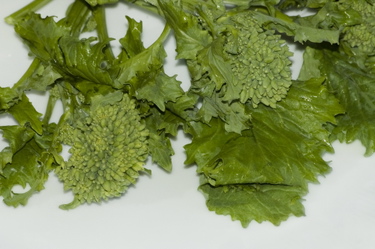Broccoli Rabe
 |
Slightly bitter, sharp and flavorful, broccoli rabe offers an exciting change of pace from your usual dinner greens. |
Also known as rapini, rabe or brocoletti di rape, this green vegetable is related to the cabbage and turnip family. Growing in thin stalks with clusters of broccoli-like florets and leaves that resemble turnip greens, broccoli rabe has a sharp, slightly bitter flavor.
The leafy green is cultivated throughout the southern Mediterranean where it has been favored since ancient Roman times. Italians are particularly fond of broccoli rabe, using it in soups and salads and cooking it in a variety of ways. First introduced to the U.S. in 1920, the vegetable is gaining popularity as of late, making appearances at gourmet markets and upscale restaurants too.
Buying Tips
Broccoli rabe is most plentiful in the late fall to early spring. Look for it in markets with specialty produce sections. Choose firm, green stems with compact heads. The flower buds that make up the florets should be tightly closed and dark green. A direct descendant of the wild mustard plants that grew along the hillsides in Messina, Sicily, broccoli rabe with the Andy Boy label is considered top of the line.
Storage Tips
Wrap the unwashed vegetable in a plastic bag and store in the refrigerator for no more than five days.
Usage Tips
To prepare broccoli rabe, rinse thoroughly in cold water and cut off the bottom stalks, which are too tough too eat. Broccoli rabe has a very bitter taste when raw, but light cooking brings out its distinctive flavor.
You can cook broccoli rabe just like broccoli by steaming, braising, sautéing or boiling. Whichever method you choose, it only needs to be cooked about eight to 10 minutes. The Italians actually prefer their broccoli rabe al dente, cooking it for only six minutes. Like spinach, its volume greatly decreases when cooked. One pound will yield only one side serving.
Serving Tips
• Sauté with <a data-cke-saved-href="/glossary/broccol%20rabe&ed=1" href="/glossary/broccol%20rabe&ed=1" garlic"="">garlic</a> and <a data-cke-saved-href="/glossary/olive%20oil" href="/glossary/olive%20oil">olive oil</a> and serve over pasta and Italian <a data-cke-saved-href="/glossary/sausage" href="/glossary/sausage">sausage</a>.<br> <br> • Add blanched, chopped broccoli rabe to cheese fillings for <a data-cke-saved-href="/recipes/lasagna/best" href="/recipes/lasagna/best">lasagna</a> and <a data-cke-saved-href="/recipes/cannelloni/best" href="/recipes/cannelloni/best">cannelloni</a>.<br> <br> • Add steamed broccoli rabe to boiled <a data-cke-saved-href="/glossary/potato" href="/glossary/potato">potatoes</a> and season with olive oil and garlic.<br> <br>• Lightly sauté and add to breakfast omelets with sun-dried tomatoes and fontina cheese.<br> <br> • Sprinkle broccoli rabe with red pepper flakes to balance its bitterness.<br> <br> </p><h3><u><b>Nutrition Notes</b></u></h3> Broccoli rabe's dark green color is a good hint that it's





